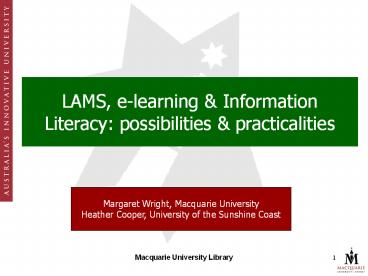LAMS, e-learning - PowerPoint PPT Presentation
Title:
LAMS, e-learning
Description:
LAMS, e-learning & Information Literacy: possibilities & practicalities Margaret Wright, Macquarie University Heather Cooper, University of the Sunshine Coast – PowerPoint PPT presentation
Number of Views:328
Avg rating:3.0/5.0
Title: LAMS, e-learning
1
LAMS, e-learning Information Literacy
possibilities practicalities
Margaret Wright, Macquarie University Heather
Cooper, University of the Sunshine Coast
2
What is LAMS?
- LAMS is a new tool for designing, managing and
- delivering online collaborative learning
activities. It - provides teachers with a highly intuitive visual
authoring - environment for creating sequences of learning
- activities. These activities can include a range
of - individual tasks, small group work and whole
class - activities based on both content and
collaboration. - Source http//lamsinternational.com/CD/
3
LAMS also
- Purpose built for online teaching
- Supports student-centered learning
- Enables sustainability through sharing and reuse
of sequences of learning activities - Provides strong support ongoing product
development
4
Teaching Information Skills in EDUC261Previous
practice and outcomes
- Practice
- Teacher-centered approach - focused on covering
content practicing skills - Outcomes
- Limited opportunity for student collaboration
- Low levels of student contribution in class lt15
- Limited student engagement in the learning process
5
Our objectives in using LAMS
- Explore the potential of LAMS as a tool to teach
information skills - Assess the implications for libraries and
librarians in using LAMS
6
EDUC261 LAMS tutorial
- Aim
- That students build a collective knowledge and
understanding of the planning phase of the
research process
7
Designing the LAMS sequence
- Objective
- Develop a sequence that encouraged students to
use higher order - learning processes and engage in deep learning
- Supported by learning activities that
- ensured active participation and student
engagement - facilitated collaboration
- developed critical analysis, critical thinking
and reflection - Supported by assessment activities that
- were relevant to the learning
8
LAMS sequence design author view
9
Monitoring student progress
10
Student evaluations
- Collaborative activities
- loved the forum activity where people gave
- opinions and it gave me definite/crucial point of
- view on how to do research
- The most useful thing I guess was that this is a
- good way to actually learn, you view info and are
- able to discuss your view with others
- I
11
Student evaluations
- Instructions
- For most students the instructions were clear and
well structured - The instructions overall were clear and well
structured. The - activities were good especially the outside
sources such as the - encyclopedia
- A few students indicated that they were a little
bit lost at times - it took me (for) a while to understand (the)
what the sequence is - all about.
12
Student evaluations
- Timing and content
- Many students commented that the content was just
right - Overall it was a good, clear lesson, without any
redundant or - irrelevant information given.
- I appreciated the ability of the sequence to
actually give you - appropriate skill without immersing you in nice
to know - information it cuts to the chase.
- A few disagreed
- the amount of info to digest is too much in the
space of 1 hour.
13
Student evaluations
- Accessibility
- A number of students commented on accessibility
- Most meaningful thing I learned was the
importance of - accessibility for all students ie the
encyclopedia site - was frustrating and caused a block in the middle
of the - learning/research process. Other things were
forgotten - and the focus became jus(t) getting into the
site.
14
Outcomes
- Despite the fact that some students did not
- have a good grasp of LAMS and were at different
phases of their learning the sequence achieved
the objective of engaging them in building a
collective knowledge - What we were trying to achieve was difficult but
was a success in that students were able to
participate in each step of the sequence
15
Critical elements to success
- Ability to navigate LAMS effectively
- Aims objectives linked to curriculum outcomes
- Clear explicit aims objectives
- Clear explicit instructions
- Descriptive sequence titles to enable navigation
- Uninterrupted access to external resources
- Appropriate use of colours and fonts
- Appropriate match of tool activity
- Effective sequencing of activities
16
Conclusions
- LAMS design and flexibility
- supports embedding Information Literacy into the
context of the learning experience - facilitates student engagement
- enables a sustainable IL solution
17
Implications for libraries and librarians
- New skill sets for librarians
- LAMS program
- Learning design - principles and practice
- New ways of working
- Partnerships and collaboration
- Resourcing
- Training and development
- Staffing
- Library resources and LAMS
- Adaptability and Compatibility
18
Final thoughts
- Limited research has been undertaken by the
library community into the use of LAMS to teach
Information Skills - Further research and testing of LAMS is required
to determine its full potential and application
in teaching Information Skills































